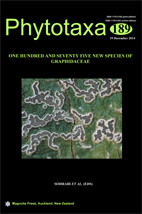Abstract
Recent studies of the global diversity of the lichenized fungal family Graphidaceae suggest that there are a large number of species remaining to be discovered. No less than 640 species have been described since 2002, including 175 new species introduced in a collaborative global effort in a single issue in this journal. These findings suggest that the largest family of tropical crustose lichens may have an even higher number of species than Parmeliaceae. To estimate whether the discovery of 175 new species is a significant step forward in cataloguing extant diversity in this family, we employed a parametric method to predict global species richness of Graphidaceae using a GIS-based grid map approach. The model employs linear regression between observed species richness and sample score and vegetation composition per grid to predict individual grid species richness, and interpolation of species grid distributions to predict global species richness. We also applied a non-parametric species-area curve approach and non-parametric species richness estimators (Chao, Jackknife, Bootstrap) to compare the results from the different methods. Our approach resulted in a prediction of 4,330 species of Graphidaceae, including approximately 3,500 (sub-)tropical species in the core subfamilies Fissurinoideae, Graphidoideae, Redonographoideae, plus 125 species restricted to extratropical regions (outside the zone between 30° northern and 30° southern latitude) and 700 species in subfamily Gomphilloideae. Currently, nearly 2,500 species are known in the family, including species not yet formally described. Thus, our model suggests that even after describing 175 species in this issue and with another approximately 140 awaiting publication, the number of species still to be discovered and described is more than 1,800, and much work remains to be done to close this substantial gap. Based on our approach, we predict that most of this undiscovered diversity is to be found in Mexico, the northern Andean region, the eastern Amazon and central and southern Brazil, tropical West Africa, continental Southeast Asia, Indonesia, and Papua New Guinea.

